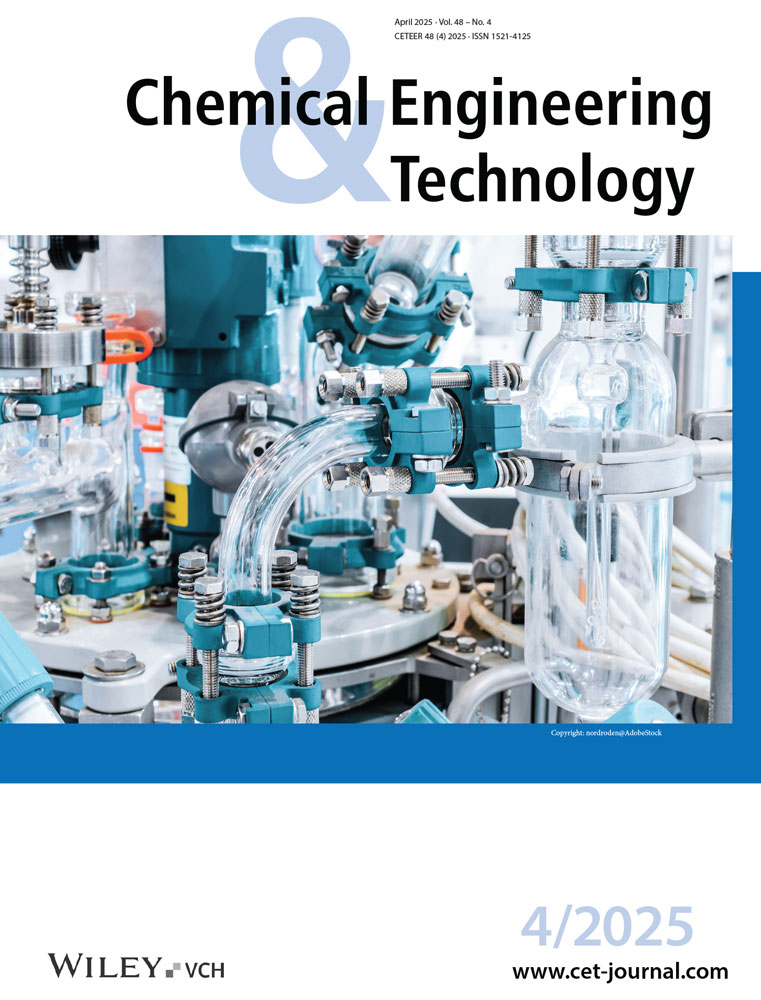Experimental Study on Breaking and Separating Cocoa Beans
Corresponding Author
Dr.-Ing. Marc Lörcher
August Storck KG, Paulinenweg 12, 33790 Halle, Westf, Germany
E-mail: [email protected]
Search for more papers by this authorPhilipp Steinke
August Storck KG, Paulinenweg 12, 33790 Halle, Westf, Germany
Search for more papers by this authorDr.-Ing. Philipp Grimm
Berief Food GmbH, Lebensweg 1, 59269 Beckum, Germany
Search for more papers by this authorDipl.-Ing. Björn Spiller
August Storck KG, Paulinenweg 12, 33790 Halle, Westf, Germany
Search for more papers by this authorProf. Dr.-Ing. Arno Kwade
Technische Universität Braunschweig, Institut für Partikeltechnik, Volkmaroder Str. 5, 38104 Braunschweig, Germany
Search for more papers by this authorCorresponding Author
Dr.-Ing. Marc Lörcher
August Storck KG, Paulinenweg 12, 33790 Halle, Westf, Germany
E-mail: [email protected]
Search for more papers by this authorPhilipp Steinke
August Storck KG, Paulinenweg 12, 33790 Halle, Westf, Germany
Search for more papers by this authorDr.-Ing. Philipp Grimm
Berief Food GmbH, Lebensweg 1, 59269 Beckum, Germany
Search for more papers by this authorDipl.-Ing. Björn Spiller
August Storck KG, Paulinenweg 12, 33790 Halle, Westf, Germany
Search for more papers by this authorProf. Dr.-Ing. Arno Kwade
Technische Universität Braunschweig, Institut für Partikeltechnik, Volkmaroder Str. 5, 38104 Braunschweig, Germany
Search for more papers by this authorAbstract
The winnowing of cocoa beans is realized by the three basic mechanical operations of crushing, sieving, and sifting. At August Storck KG, different plants are used for the winnowing process. In the following paper, two plants are compared with regard to the procedural processes, and the respective advantages and disadvantages are analyzed and explained. The success of the winnowing plants is determined by two parameters: The shell content in the product stream is used to evaluate quality, and the nib content in the shell stream allows conclusions about economic efficiency.
References
- 1N. Cain, C. Marji, K. von Wuthenau, T. Segelke, M. Fischer, Metabolites 2020, 10, 91. DOI: 10.3390/metabo10030091.
- 2E. Teye, E. Anyidoho, R. Agbemafle, L. K. Sam-Amoah, C. Elliott, Infrared Phys. Technol. 2020, 104, 103127. DOI: 10.1016/j.infrared.2019.103127.
- 3E. O. Afoakwa, J. Quao, J. Takrama, A. S. Budu, F. K. Saalia, J. Food Sci. Technol. 2013, 50, 1097–1105. DOI: 10.1007/s13197-011-0446-5.
- 4S. T. Beckett, Industrial chocolate manufacture and use, 4th ed., Wiley-Blackwell, Chichester 2009.
- 5 Codex alimentarius, Standard For Cocoa (Cacao) Mass (Cocoa/Chocolate Liquor) And Cocoa Cake: Cxs 141–1983, Food and Agriculture Organization of the United States, World Health Organization, 2014.
- 6K. Grob, J. Agric. Food Chem. 2018, 66, 6968–6974. DOI: 10.1021/acs.jafc.8b02225.
- 7S. Warentest, Adventskalender mit Schokoladenfüllung – Die Mineralöl-Typen – Stiftung Warentest, 2021. https://www.test.de/Adventskalender-mit-Schokoladenfuellung-Mineraloel-in-der-Schokolade-4471436-4471439/(Accessed May 22, 2021)
- 8R. Matissek, A. Dingel, J. Schnapka, Minimierung von Mineralölbestandteilen in Lebensmitteln, WPD Moderne Ernährung heute, LCI, Köln, Nr. 4 / Juli 2016.
- 9 Bundesinstitut für Risikobewertung, Mineralölbestandteile in Lebensmitteln 2020. https://www.bfr.bund.de/de/fragen_und_antworten_zu_mineraloelbestandteilen_in_lebensmitteln-132213.html. (Accessed on February 4, 2021)
- 10 Lebensmitelchemisches Institut des Bundesverbandes der Deutschen Süßwarenindustrie, Charakterisierung von MOSH/MOAH-Einträgen in Lebensmittel mittels GCxGC-ToF-MS 2014.
- 11T. Scholz, Besprechung der Entschalungsanlagen KV01 und KV02, August Storck KG 2020.
- 12A. Stauff, J. Schnapka, F. Heckel, R. Matissek, Eur. J. Lipid Sci. Technol. 2020, 122, 1900383. DOI: 10.1002/ejlt.201900383.
- 13S. Stähle, R. Helling, Orientierungswerte für Mineraölkohlenwasserstoffe (MOH) in Lebensmitteln, Länderarbeitergemeinschaft Verbraucherschutz und Lebensmittelverband Deutschland, Berlin 1/2024.
- 14R. Heiss, Lebensmitteltechnologie: Biotechnologische, chemische, mechanische und thermische Verfahren der Lebensmittelverarbeitung, Springer, Berlin Heidelberg 1991.
10.1007/978-3-662-08283-6 Google Scholar
- 15E. H. Meursing, DeZaan cocoa manual: Cocoa & chocolate manual, 14th ed., deZaan, Koog aan de Zaan 2009.
- 16H. P. Schuchmann, H. Schuchmann, Lebensmittelverfahrenstechnik, Wiley-VCH, Weinheim 2005.
10.1002/9783527623549 Google Scholar
- 17 Food Masters Freiberg GmbH, Betriebsanleitung Prallbrecher CBRB 80: Auftrag: 11150-00-00, Food Masters Freiberg GmbH, Freiberg am Neckar 2019.
- 18B. Ag, Barth Winnower—Two stage crushing process. https://www.buhlergroup.com/content/buhlergroup/global/fr/products/barth_winnower.html. (Accessed on January 25, 2021)
- 19T. Technik, Trenn- und Sortierttechnik GmbH, Betriebsanleitung Siebmaschine SIK: 0600_SIK-Leben-standard_1-0_DE, Trenn- und Sortierttechnik GmbH, Weißenhorn 2019.
- 20G. W. Barth AG, Betriebsanleitung: Brech- und Reinigungsmaschine W2400/W4000, Freiberg/Neckar, 2004.
- 21G. W. Barth AG, Technology for the future: Entschalungsanlage W 2400 –8000, Freiberg/Neckar, 2004.
- 22M. Stieß, Mechanische Verfahrenstechnik-Partikeltechnologie 1, 3rd ed., Springer, Berlin, 2009.
- 23F. Kaiser, Chem. Ing. Tech. 1963, 35, 273–282.
10.1002/cite.330350405 Google Scholar
- 24M. Hundertmark, Analyse und Verbesserung eines Kakaovearbeitungsprozesses, Ruhr-Universität Bochum, 2014.
- 25A. Bart-Plange, E. A. Baryeh, J. Food Eng. 2003, 60 219–227. DOI: 10.1016/S0260-8774(02)00452-1.
- 26R. S. Amoah, E. E. Abano, E. K. Anyidoho, J. Food Process. Eng. 2017, 40, e12348. DOI: 10.1111/jfpe.12348.
- 27 Retsch GbmH, Betriebsanleitung Vibrationssiebmaschine AS 200 Digit CA, Haan, 2020.
- 28 Cocoatown, Cocoatown deluxe Winower: Tech. Rep. 2020. https://cocoatown.com/collections/winnowers/products/cocoat-deluxe-winnower. (Accessed on December 18, 2020)
- 29G. W. Barth AG, Betriebanleitung Wurfbrecher, Brech- und Reinigungsmaschine.
- 30T. Technik, Trenn- und Sortierttechnik GmbH, Betriebsanleitung Windsichtereinheit: ZZS180/600/6-Kat. 1. 18-40081-ZZS-EH, Trenn- und Sortierttechnik GmbH, Weißenhorn 2018.
- 31T. Technik, Trenn- und Sortierttechnik GmbH, Betriebansleitung Trenntisch TTS: 0500_TTS, Trenn- und Sortierttechnik GmbH, Weißenhorn 2017.
- 32W. Müller, Mechanische Verfahrenstechnik und ihre Gesetzmäßigkeiten, 2nd ed., De Gruyter, Berlin 2014.
10.1524/9783110343564 Google Scholar
- 33P. Schmidt, Chem. Ing. Tech. 1984, 56, 897–907. DOI: 10.1002/cite.330561205.
- 34H. Schubert, Handbuch der Mechanischen Verfahrenstechnik, Wiley-VCH Verlag HmbH & Co., KGaA, Weinheim 2003.
- 35K. Schwister, Taschenbuch der Verfahrenstechnik, Hanser, Munich.
- 36 C. T. Crowe, D. F. Elger, J. A. Roberson, (Eds.), Engineering fluid mechanics, Wiley-VCH Verlag HmbH & Co. KGaA, New York 2001.
- 37M. Bohnet, Mechanische Verfahrenstechnik, Wiley-VCH Verlag, 1. Auflage, Braunschweig, 2004.
- 38A. Kaas, T. Mütze, U. A. Peuker, Review on Zigzag Air Classifier, Processes 2022, 764. DOI: https://doi.org/10.3390/pr10040764.
10.3390/pr10040764 Google Scholar
- 39D. Behrens, Chem. Ing. Tech. 1965, 37, 473–483. DOI: 10.1002/cite.330370503.
- 40R. Polke, M. Schäfer, N. Scholz, in Handbuch der Mechanischen Verfahrenstechnik, John Wiley & Sons, Ltd, Hoboken, NJ 2005, 91–100.




